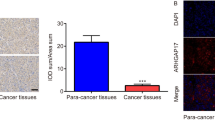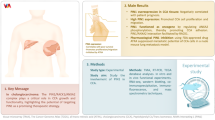Abstract
This study aimed to investigate the expression of PEBP4 protein in colorectal carcinoma tissues and its correlation with the clinical pathology of colorectal cancer and to investigate the relationship between PEBP4 expression and the invasion and metastasis of colorectal cancer cells, which could provide an experimental basis for future biological treatments of human colorectal cancer. RT-PCR and western blot methods were applied to detect the mRNA and protein expressions, respectively, of PEBP4 in colorectal cancer tissues and normal pericarcinoma tissues, and their correlations with the tumorigenesis and development of colorectal cancer, as well as its clinical pathology, were analyzed. Using the RNA interference technology, the expression of PEBP4 was knocked down in the human colorectal cancer cell HCT116, and the changes of the invasion capability of HCT116 were monitored. The positive mRNA expression rate of PEBP4 in colorectal cancer tissue was significantly higher than that in the normal pericarcinoma tissue (p < 0.05). Also, the positive expression rate in the cancer tissues from patients with positive lymph node and distant metastasis was significantly higher than that from the patients negative for lymph node and distant metastasis (p < 0.05). The positive expression rate of PEBP4 in the cancer tissues from the patients in early stages (I, II) was significantly lower than the expression rate in patients in advanced stages (III, IV) (p < 0.05). A lower degree of differentiation in colorectal cancer corresponded to a higher positive mRNA expression rate of PEBP4 (p < 0.05). However, this was independent of the patient’s gender, age, and tumor size (p > 0.05). In colorectal cancer tissue, the expression of PEBP4 protein was consistent with its mRNA. Namely, PEBP4 protein expression in colorectal cancer tissues was significantly higher than that in the normal pericarcinoma tissues (p < 0.05), the expression in the cancer tissues from the patients with positive lymph node and distant metastasis was significantly higher than that from the patients who were negative for these metastases (p < 0.05), and a lower degree of differentiation in colorectal cancer corresponded to a higher TNM staging along with a higher PEBP4 protein expression (p < 0.05). After HCT116 cells transfected with PEBP4 siRNA, they showed a significantly lower expression level of PEBP4 protein (p < 0.05), and the number of cells that passed through the Transwell chamber was significantly lower compared to the non-transfected or the transfected controls (p < 0.05). The over-expression of PEBP4 protein may be related to the tumorigenesis, development, metastasis, and invasion of colorectal cancer.


Similar content being viewed by others
References
Jemal A, Siegel R, Xu J, Ward E. Cancer statistics, 2010. CA Cancer J Clin. 2010;60:277–300.
LoConte N, Williamson A, Gayle A, Weiss J, Leal T, Cetnar J, Mohammed T, Tevaarwerk A, Jones N. Increasing disparity in colorectal cancer incidence and mortality among African Americans and whites: a state’s experience. J Gastrointest Oncol. 2011;2:85–92.
Katkoori V, Suarez-Cuervo C, Shanmugam C, Jhala N, Callens T, Messiaen L, Posey III J, Bumpers H, Meleth S, Grizzle W, Manne U. Bax expression is a candidate prognostic and predictive marker of colorectal cancer. J Gastrointest Oncol. 2010;1:76–89.
Chen Y, Chung V. Challenges toward personalized treatment of localized colorectal cancer. J Gastrointest Oncol. 2010;1:74–5.
Fakih M. Predictive or non-predictive, prognostic or non-prognostic: dilemmas generated through small retrospective studies. J Gastrointest Oncol. 2010;1:72–3.
Yeung K, Seitz T, Li S, Janosch P, McFerran B, Kaiser C, Fee F, Katsanakis KD, Rose DW, Mischak H, et al. Suppression of Raf-1 kinase activity and MAP kinase signalling by RKIP. Nature. 1999;401:173–7.
Corbit KC, Trakul N, Eves EM, Diaz B, Marshall M, Rosner MR. Activation of Raf-1 signaling by protein kinase C through a mechanism involving Raf kinase inhibitory protein. J Biol Chem. 2003;278:13061–8.
Shemon AN, Heil GL, Granovsky AE, Clark MM, McElheny D, Chimon A, Rosner MR, Koide S. Characterization of the Raf kinase inhibitory protein (RKIP) binding pocket: NMR-based screening identifies small-molecule ligands. PLoS One. 2010;5:e10479.
Wang X, Li N, Liu B, Sun H, Chen T, Li H, Qiu J, Zhang L, Wan T, Cao X. A novel human phosphatidylethanolamine-binding protein resists tumor necrosis factor alpha-induced apoptosis by inhibiting mitogen-activated protein kinase pathway activation and phosphatidylethanolamine externalization. J Biol Chem. 2004;279:45855–64.
Qiu J, Xiao J, Han C, Li N, Shen X, Jiang H, Cao X. Potentiation of tumor necrosis factor-alpha-induced tumor cell apoptosis by a small molecule inhibitor for anti-apoptotic protein hPEBP4. J Biol Chem. 2010;285:12241–7.
Liu H, Qiu J, Li N, Chen T, Cao X. Human phosphatidylethanolamine-binding protein 4 promotes transactivation of estrogen receptor alpha (ERalpha) in human cancer cells by inhibiting proteasome-dependent ERalpha degradation via association with Src. J Biol Chem. 2010;285:21934–42.
Phelip J, Bageacu S, Baconnier M, Barabino G, Tedesco E, Benhamou P, Roblin X. Comparison of adiponectin concentration between pancreatic cancer and colorectal cancer. J Gastrointest Oncol. 2011;2:232–9.
Garcia R, Grindlay J, Rath O, Fee F, Kolch W. Regulation of human myoblast differentiation by PEBP4. EMBO Rep. 2009;10:278–84.
Yeung K, Janosch P, McFerran B, Rose DW, Mischak H, Sedivy JM, Kolch W. Mechanism of suppression of the Raf/MEK/extracellular signal-regulated kinase pathway by the raf kinase inhibitor protein. Mol Cell Biol. 2000;20:3079–85.
Winn RA, Marek L, Han SY, Rodriguez K, Rodriguez N, Hammond M, Van Scoyk M, Acosta H, Mirus J, Barry N, et al. Restoration of Wnt-7a expression reverses non-small cell lung cancer cellular transformation through frizzled-9-mediated growth inhibition and promotion of cell differentiation. J Biol Chem. 2005;280:19625–34.
Li P, Wang X, Li N, Kong H, Guo Z, Liu S, Cao X. Anti-apoptotic hPEBP4 silencing promotes TRAIL-induced apoptosis of human ovarian cancer cells by activating ERK and JNK pathways. Int J Mol Med. 2006;18:505–10.
Li H, Wang X, Li N, Qiu J, Zhang Y, Cao X. hPEBP4 resists TRAIL-induced apoptosis of human prostate cancer cells by activating Akt and deactivating ERK1/2 pathways. J Biol Chem. 2007;282:4943–50.
Niquet J, Wasterlain CG. Bim, Bad, and Bax: a deadly combination in epileptic seizures. J Clin Invest. 2004;113:960–2.
Jeong SJ, Pise-Masison CA, Radonovich MF, Park HU, Brady JN. Activated AKT regulates NF-kappaB activation, p53 inhibition and cell survival in HTLV-1-transformed cells. Oncogene. 2005;24:6719–28.
Ahmed NN, Grimes HL, Bellacosa A, Chan TO, Tsichlis PN. Transduction of interleukin-2 antiapoptotic and proliferative signals via Akt protein kinase. Proc Natl Acad Sci U S A. 1997;94:3627–32.
Lee MY, Ryu JM, Lee SH, Park JH, Han HJ. Lipid rafts play an important role for maintenance of embryonic stem cell self-renewal. J Lipid Res. 2010;51:2082–9.
Wang X, Li N, Li H, Liu B, Qiu J, Chen T, Cao X. Silencing of human phosphatidylethanolamine-binding protein 4 sensitizes breast cancer cells to tumor necrosis factor-alpha-induced apoptosis and cell growth arrest. Clin Cancer Res. 2005;11:7545–53.
Zhang Y, Wang X, Xiang Z, Li H, Qiu J, Sun Q, Wan T, Li N, Cao X, Wang J. Promotion of cellular migration and apoptosis resistance by a mouse eye-specific phosphatidylethanolamine-binding protein. Int J Mol Med. 2007;19:55–63.
Qian Y, Corum L, Meng Q, Blenis J, Zheng JZ, Shi X, Flynn DC, Jiang BH. PI3K induced actin filament remodeling through Akt and p70S6K1: implication of essential role in cell migration. Am J Physiol Cell Physiol. 2004;286:C153–63.
Syed DN, Afaq F, Sarfaraz S, Khan N, Kedlaya R, Setaluri V, Mukhtar H. Delphinidin inhibits cell proliferation and invasion via modulation of Met receptor phosphorylation. Toxicol Appl Pharmacol. 2008;231:52–60.
Grille SJ, Bellacosa A, Upson J, Klein-Szanto AJ, van Roy F, Lee-Kwon W, Donowitz M, Tsichlis PN, Larue L. The protein kinase Akt induces epithelial mesenchymal transition and promotes enhanced motility and invasiveness of squamous cell carcinoma lines. Cancer Res. 2003;63:2172–8.
Zuo JH, Zhu W, Li MY, Li XH, Yi H, Zeng GQ, Wan XX, He QY, Li JH, Qu JQ, et al. Activation of EGFR promotes squamous carcinoma SCC10A cell migration and invasion via inducing EMT-like phenotype change and MMP-9-mediated degradation of E-cadherin. J Cell Biochem. 2011;112:2508–17.
Kim D, Kim S, Koh H, Yoon SO, Chung AS, Cho KS, Chung J. Akt/PKB promotes cancer cell invasion via increased motility and metalloproteinase production. FASEB J. 2001;15:1953–62.
Yu HG, Li JY, Yang YN, Luo HS, Yu JP, Meier JJ, Schrader H, Bastian A, Schmidt WE, Schmitz F. Increased abundance of cyclooxygenase-2 correlates with vascular endothelial growth factor-A abundance and tumor angiogenesis in gastric cancer. Cancer Lett. 2003;195:43–51.
Maroni P, Matteucci E, Luzzati A, Perrucchini G, Bendinelli P, Desiderio MA. Nuclear co-localization and functional interaction of COX-2 and HIF-1alpha characterize bone metastasis of human breast carcinoma. Breast Cancer Res Treat. 2011;129:433–50.
Tahanian E, Sanchez LA, Shiao TC, Roy R, Annabi B. Flavonoids targeting of IkappaB phosphorylation abrogates carcinogen-induced MMP-9 and COX-2 expression in human brain endothelial cells. Drug Des Devel Ther. 2011;5:299–309.
Conflicts of interest
None
Author information
Authors and Affiliations
Corresponding author
Rights and permissions
About this article
Cite this article
Liu, H., Kong, Q., Li, B. et al. Expression of PEBP4 protein correlates with the invasion and metastasis of colorectal cancer. Tumor Biol. 33, 267–273 (2012). https://doi.org/10.1007/s13277-011-0279-x
Received:
Accepted:
Published:
Issue Date:
DOI: https://doi.org/10.1007/s13277-011-0279-x




